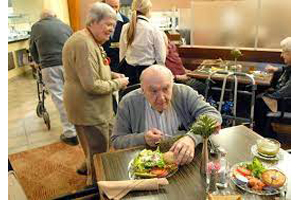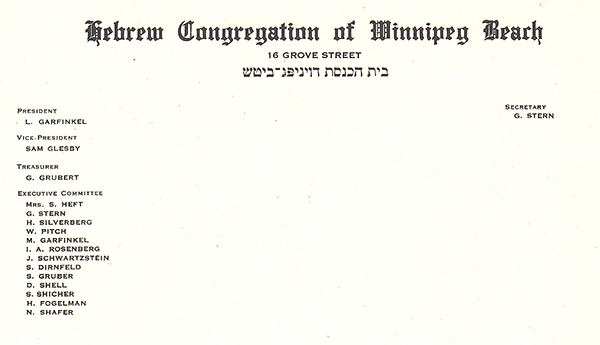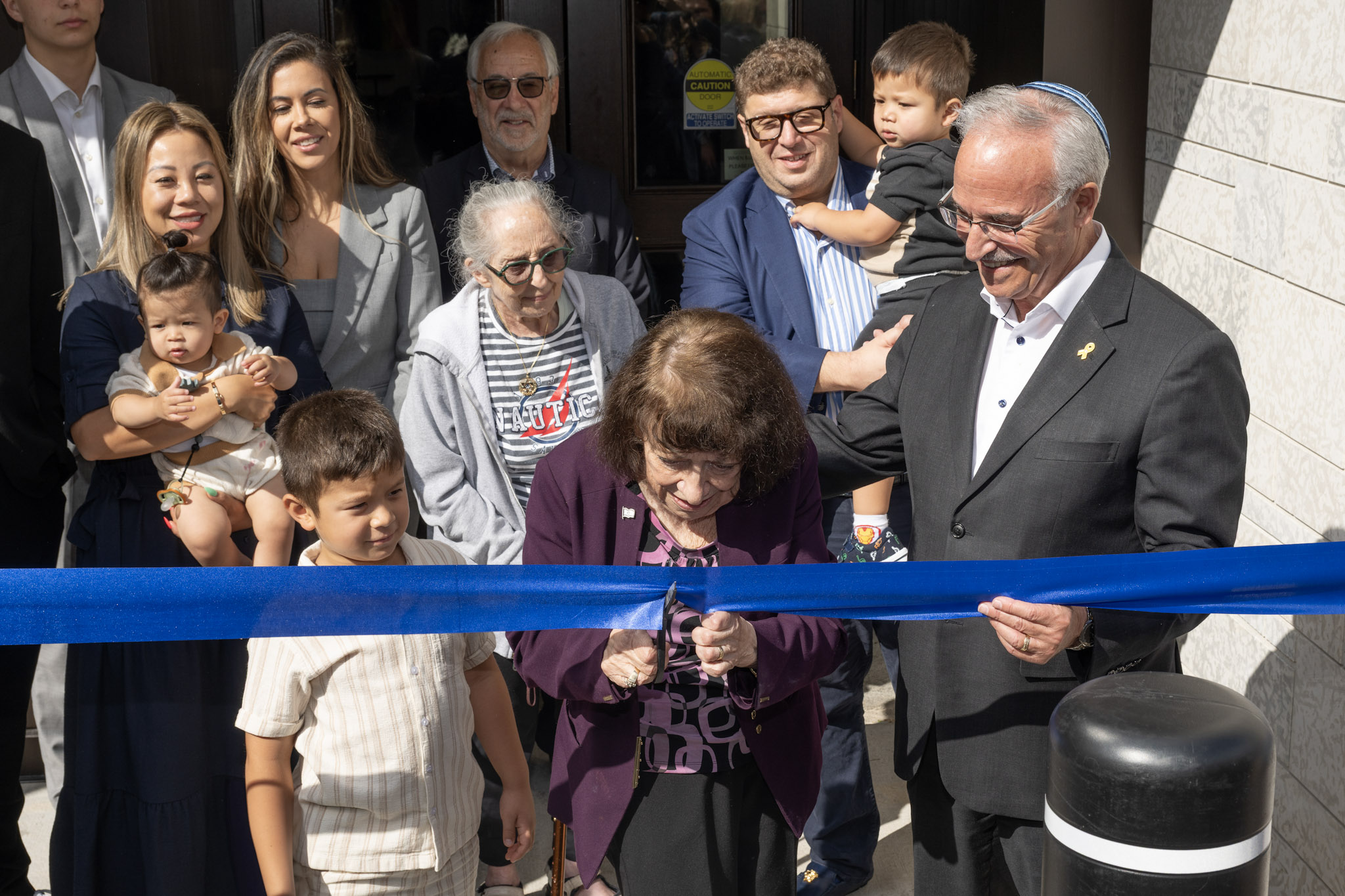Local News
The debate over whether Jewish seniors’ homes need to be fully kosher
 In recent issues of The Jewish Post & News we’ve been debating whether the Simkin Centre needs to remain a fully kosher facility. Following are a number of different letters that were published in the Feb. 16 issue of the print edition, followed by an article that ran in Tablet magazine in 2019 which examined the increasing number of Jewish seniors’ homes in the US that have gone non-kosher:
In recent issues of The Jewish Post & News we’ve been debating whether the Simkin Centre needs to remain a fully kosher facility. Following are a number of different letters that were published in the Feb. 16 issue of the print edition, followed by an article that ran in Tablet magazine in 2019 which examined the increasing number of Jewish seniors’ homes in the US that have gone non-kosher:
On Fri, Feb 4, 2022 I sent the following email to Rabbi Yosef Benarroch, who is both the spiritual leader of Adas Yeshurun – Herzlia congregation, also the head of the Vaad Hakashrut of Winnipeg:
Hi Rabbi,
I assume you’re still in Israel as I write this. I hope you’re staying warmer there than we are here.
As usual, I’ve asked a question that might get some people wondering about a subject that doesn’t get raised often, this time it’s kashrut at the Simkin Centre.
I’ve been trying to find out just how many of the residents there aren’t Jewish, but so far Laurie Cerqueti (the CEO of Simkin Centre) hasn’t answered that question.
The reason I ask is that some of the Jewish residents are wondering what’s happening to the home, what with all the non-Jewish residents who have come in in recent years.
At the same time, I’ve been wondering whether it would be possible to have non kosher food in the centre.
The CEO of the Louis Brier Home in Vancouver wrote to me that, while that facility still serves only kosher food, residents are allowed to bring non kosher food in, so long as they eat it only in their rooms.
Would such a policy be acceptable at the Simkin Centre?
Stay safe – and good Shabbes.
-Bernie
(I should note that in my Short takes column of Feb. 2 I suggested that the Simkin Centre ought to consider going nonkosher, as have so many Jewish seniors’ homes in the US. Further, since I sent this email I have been advised that residents are indeed allowed to eat non-kosher food, so long as it is eaten only in their rooms.)
On Feb. 6 Rabbi Yosef Benarroch responded
Bernie
I was quite surprised to read your piece on the Simkin advocating for the facility to go non kosher and provide packaged meals for those who want kosher. In the seven years that I have been overseeing Kashrut at the Simkin there has not been a single such request. Not from the administration, not from residents and not from families including the non Jewish residents. The quality of the food is excellent and I can say this first hand with my mother being a resident. I find it puzzling and shocking that the “Jewish” newspaper of the city would be advocating to turn the Jewish seniors home in Winnipeg not kosher.
My best
Rabbi Yosef Benarroch
******
I am writing on behalf of the Board of Directors of the Saul and Claribel Simkin Centre regarding your column in the February 2nd edition of the Jewish Post and News. This relates to your questions about the Centre providing our residents with a Kosher diet, and the ratio of Jewish to non-Jewish residents.
Regarding our use of Kosher food, we are not attempting to “maintain a pretense of keeping Kosher,” as you stated in your column, but to adhere to the principles and values of the Centre going back to its days as the Sharon Home. This topic comes up at Board meetings from time to time, and the Board consistently supports the continuation of this tradition. We pride ourselves on the quality of the freshly made Kosher food we provide our residents, and plan to continue doing so.
Regarding the ratio of Jewish to non-Jewish residents, over the years approximately 60% to 65% of our residents have been Jewish. As Laurie Cerqueti noted when you contacted her, the numbers vary over time. While we welcome people of all faiths at the Centre, we try to maintain open rooms for Jewish people in the community who need the support we provide in a timely fashion. I was surprised when you stated that Laurie “is worried that the figures [regarding the number of Jewish residents] might come as shock to Jewish Winnipeggers.” Under Laurie’s leadership the Simkin Centre, during the current pandemic, has been one of the most open and transparent organizations in the city. The ratio of Jewish to non-Jewish residents is not a secret to be kept from the Community, but a fact based on the number of Jewish community members needing and wanting to reside with us.
Sincerely,
Gerry Kaplan, MSW
Chair,
Saul and Claribel Simkin Centre Board of Directors
******
In your most recent Short Takes column you commented on the apparent declining percentage of Jewish residents at The Simkin Centre Personal Care Home. You attributed the decline in the Jewish census at the Centre to the fact that the actual number of Jewish people in the community had declined and that there were alternatives to personal care home care, such as assisted living, which together meant that demand for personal care home beds had declined within the Jewish community.
While I think your reasoning on why there are fewer Jewish people in The Centre is correct, it is important to recognize the significant difference in the eligibility criteria for personal care home admission currently in Manitoba as opposed to 30 years ago when the Sharon Home on Magnus would have had a 100% Jewish population. In the old days places like the Sharon Home were more like retirement residences and people could move into them experiencing far less disability than is currently required for PCH admission. People who moved in were much younger and lived in the Home much longer. With a significantly larger Jewish population in Winnipeg in those days it was a given that very few non Jewish people would be admitted, if at all. Currently, people who are admitted into personal care homes are much more debilitated both physically and cognitively and the turnover in residents is much quicker. Combined with the decline in the Winnipeg Jewish population from its peak of 25,000 to what is now probably less then 15,000 it is a given that when a bed becomes available at the Centre it is more likely to be occupied by a non Jewish person – this in spite of the fact that Jewish people continue to be a priority for admission. Within 5 years the Jewish population at the Centre could fall to 25% or less.
Your comments about the continued provision of solely kosher food at the Centre are good ones. According to surveys in the United States only 15% to 20% of Jewish people are kosher. Fully 65% of non orthodox Jewish people in the US eat pork products and only 10% of American Jews identify themselves as orthodox. I suspect that the Canadian Jewish population is not much different. Being kosher is not a characteristic that defines Jewish identity for a great majority of Jewish people. In my time at The Centre it was clear that many Jewish people entering the facility had not been leading kosher lives before they entered. When you combine that reality with the fact that a majority of the Centre’s residents are not Jewish it might be time to rethink the current kosher policy. As you have pointed out this is already happening in Jewish care facilities and seniors’ residences in the United States.
Irwin Corobow
Ed. note: Irwin Corobow is a former CEO of the Simkin Centre.
The figures Irwin gives for the Jewish population of Winnipeg are not quite correct. The highest number ever reported in the census occurrred in 1961, when the Jewish popuation was just short of 20,000. The 2011 National Household Survey (which replaced the census that year) indicates that there were, at most, 12,500 Jews in Winnipeg that year. The 2016 census reported only 7,640 Jews in Winnipeg, but that figure has been largely discredited. We’re anxiously awaiting results of the 2021 census.
*****
Jewish senior residences shift away from kosher food
Whether it’s done to save money, or to respect residents’ personal choices, the menus are changing
The following article appeared in the online magazine, “Tablet”, on April 28, 2019.
By JUNE D. BELL
Before the Sinai Residences in Boca Raton, Florida, opened in 2016, several hundred Jewish seniors who’d put down deposits received a survey about meals. Specifically, how important was kosher food?
Not important at all, it turned out. If Sinai were exclusively kosher, the vast majority said, they’d rescind their deposits. “They said having a kosher option was great, but being completely kosher would deter them from moving in,” said Chris Newport, Sinai’s executive director.
The Jewish Federation of South Palm Beach County, which developed the not-for-profit senior community, scrapped plans for a kosher kitchen. Pork and shellfish aren’t on the menu, but residents can dine on cheeseburgers and chicken Parmesan. All 234 independent-living apartments are occupied, and more than 60 people are on the waiting list.
Sinai is far from the only senior residence touting nonkosher fare in a Jewish communal setting. From Philadelphia to Silicon Valley, communities for aging Jews have been succumbing to a host of pressures to expand their menus beyond the limits of kashrut.
Some of that pressure is financial. Facilities pay a premium for kosher supervision of two kitchens with at least two sets of dishes and cutlery, and hekhshered meats, cheeses, and other products cost more than their nonkosher counterparts. But residents themselves exert an outsize influence on the menus of the communities where they plan to spend their last years. Many find kosher fare at best uninspiring and at worst, irrelevant. Their perspective reflects the paradoxical, quixotic relationship that most American Jews have with kosher food: It may be a good thing, but it’s not necessarily my thing.
*
About 1 in 5 Jewish Americans—22%—keep kosher at home, according to a 2013 Pew Research Center . The more observant you are, the more likely you are to have a kosher home: 92% of Orthodox Jews said they have kosher kitchens, as did 31% of Conservative Jews and 7% of Reform Jews. The survey didn’t ask about food choices in restaurants or elsewhere.
Beverly Gareleck, who has kept a kosher home for more than five decades, lives in one of the 182 apartments at MorseLife’s Levin Palace in West Palm Beach, Florida. She regularly eats in the kosher dining room, which is supervised by the Orthodox Rabbinical Board of Broward and Palm Beach Counties. “I’m very happy to have the kosher restaurant. It means a lot to me,” said Gareleck, a Buffalo, New York, native. “It’s silly, but I feel it’s healthier, and it’s been looked at and taken care of in a better way.”
But if shrimp is on the menu in the nonkosher dining room, Gareleck will forgo kosher chicken pilaf, brisket, or prime rib. And when a group of friends plans a nonkosher meal, she’ll join them. About half of the 220 Palace residents opt for a kosher dinner each night, but only about 45 eat solely kosher food, said Keith A. Myers, president and CEO of MorseLife Health System.
The kosher versus nonkosher debate at Jewish senior residences was absent from this month’s conference agenda of the Association of Jewish Aging Services—not because it’s a topic members are afraid to discuss, but because they’ve already discussed it so much. “People are tired of talking about it,” said Stuart Almer, the conference’s co-chair and president and CEO of the Gurwin Jewish Nursing & Rehabilitation Center on Long Island. “It’s a sensitive issue to remain kosher or not.” About 20 of Gurwin’s 460 residents eat nothing but kosher food. At Long Island’s Parker Jewish Institute, where Almer previously worked, 20 of about 525 residents consistently ate food prepared in the kosher kitchen.
*
Relocating to a senior independent living community can be a fraught decision. Seniors must leave a familiar neighborhood and acknowledge the potential need for services such as assisted living and skilled nursing that “continuum of care” facilities offer.
Communal meals in a new residence help ease that transition and combat the loneliness and isolation many seniors experience. “It is really important; I can’t emphasize it enough,” said Joan Denison, executive director of Covenant Place in St. Louis, where as many as 100 seniors—most of them Jewish— eat a subsidized kosher meal five nights a week.
Matzo ball soup and challah are a comforting sight on a Friday night table, invoking a shared culture and history. “The food is a very easy item to say what makes a facility Jewish,” Almer said. “Food is a big part of it. It’s an obvious and tangible thing.”
When seniors choose a community, the meals—their quality, variety, taste, and presentation—carry disproportionate weight. “If you’re in your 80s or 90s, what’s the only thing you can control?” said Newport, of Sinai Residences. “You maybe can’t drive any more, your family has passed away or your kids are grown up and your spouse may have died. You can control only one thing: your food.”
Administrators are paying close attention, particularly as 10,000 baby boomers turn 65 every day, a that will continue through the next decade. “The preferences of our senior-living residents are what’s really going to drive our business model,” Newport said. “As long as the residents are able to have the things they want in their lives, that’s what’s going to really trigger them to move into senior living.”
Enticing Jewish elders means accommodating their preferences, said Martin Goetz, CEO of River Garden Senior Services in Jacksonville, Florida. “If there is a trend, it’s away from kosher or ‘kosher is optimal.’ That’s for survival.” That shift is occurring across the country, either in one fell swoop or by degrees.
In Philadelphia, ownership changes and residents’ preferences led two predominately Jewish senior residences—Martins Run Senior Residential Community and the Golden Slipper Health and Rehab Center—to eliminate their kosher kitchens. Golden Slipper, now the Glendale Uptown Home, transitioned to kosher-style meals in 2013 for its 200 residents, most of whom were Jewish.
Martins Run in Media, Pennsylvania, added a nonkosher kitchen after requests from prospective and current residents. The community was eventually acquired by Wesley Enhanced Living, which has roots in the Evangelical Association of Churches. Wesley’s still touts its “kosher food of the highest standards under strict rabbinical supervision.” The four remaining residents who keep kosher eat their prepared dinners together at a single table. “Am I disappointed? Yes,” said Ethel Hamburger, 91, who chose Martins Run 12 years ago for its kosher food and Jewish population. “It’s not the place it was.” A Wesley spokeswoman declined comment.
*
New cafes opening this spring on Jewish community center campuses that include senior residences in St. Louis and West Palm Beach will be serving nonkosher food to Jewish seniors, their families, and the community.
The kosher kitchens on the 50-acre MorseLife campus in West Palm Beach feed residents of the assisted living center, adult day care programs, a kosher Meals on Wheels program, students at four Jewish schools, and seniors who eat in the kosher dining rooms in the Palace, where Gareleck lives. But the bistro that opens on campus in June—where Palace residents will be able to eat at no charge, since their meals are included—will serve food from the nonkosher kitchen in the independent-living building.
Covenant Place in St. Louis is part of the Millstone Campus, which includes the St. Louis JCC, the federation, and the va’ad. In June, a new building is set to open that will include
medical services, physical therapy, and geriatric care facilities, as well as a new café. Seniors who live in Covenant Place’s 355 apartments—which each have kitchens—can eat at the new bistro on campus if they wish; it’s also open to everyone else, including health-care staff who serve the seniors and families who use the JCC.
“We had a big debate: Should we be kosher or nonkosher,” said Denison. The compromise was a dairy kitchen under rabbinic supervision and a meat one that is not. As many as 100 seniors who pay $3.50 for subsidized communal dinners catered by Kohn’s Kosher Meat and Deli Restaurant will have to opt for a dairy dinner if they want a kosher meal; meat meals will be made in-house, in the nonkosher kitchen.
Denison views the two cafes as a win-win: Kosher-observant families can enjoy a meal out together, and those who want more choices and affordable options can have that, too. “The key is to just be respectful,” she said, “and try to serve the whole gamut of those choices.”
Despite pressures to abandon kosher fare, some proponents are holding their ground, at least for now. When Alexander Ben-Israel became executive director of the 193-unit Moldaw Residences on the Taube Koret Center for Jewish Life in Palo Alto, California, three years ago, prepackaged kosher entrees were “miserable” and mushy. Ben-Israel brought the kosher program in-house, adding a mashgiach, multiple sets of dishes, and meat and dairy dishwashers. Participation doubled to about 25 residents.
“We had a philosophical commitment to the residents to offer kosher dining,” Ben-Israel said. “It’s just the right thing to do, that people who lived a kosher life all their lives would be able to continue to do it. … We call ourselves a Jewish facility, and it would feel kind of funny not offering it.”
But a nonkosher meal costs $15 to make, and a kosher one costs $27, adding an extra $70,000 a year to Moldow’s expenses. The facility is covering the difference for now, though it may eventually be passed on to residents.
In Jacksonville, kosher food costs River Garden an additional $300,000 a year even with staff—not rabbinic—supervision, “but that’s the cost of being who we are,” Goetz said. “We hold ourselves out to serve the entire community. … If Jews no longer connect with their synagogues, at least they are in a place that feels Jewish, does Jewish, and sounds Jewish, even if they’re not observant.” River Garden is Northeast Florida’s sole Jewish senior residence and nursing home.
Goetz, who has been CEO for 40 years, knows better than to ask the seniors what they want to eat. “We don’t put kosher on the agenda to be voted on by residents, because it would fail,” he said. “The residents here love bacon, ham, shrimp, and lobster.”
One day, some might get it. “I see the trend continuing away from kosher. I think it’s inexorable,” Goetz said. “I’m not willing to go out of business because I’m a kosher facility. If no one’ll come here because I’m kosher and it’s too expensive to serve it, I’d need to revisit our mission and our philosophy.”
***
This story originally appeared in Tablet magazine, at tabletmag.com, and is reprinted with permission.
Local News
Thank you to the community from the Chesed Shel Emes

We’re delighted to share a major milestone in our Capital Campaign, “Building on our Tradition.” Launched in November 2018, this campaign aimed to replace our outdated facility with a modern space tailored to our unique needs. Our new building is designed with ritual at its core, featuring ample preparation space, Shomer space, and storage, creating a warm and welcoming environment for our community during times of need.
We’re grateful to the nearly 1,000 generous donors who contributed over $4 million towards our new facility. A $750,000 mortgage will be retired in November 2025, completing this monumental project in just seven years.
We’re also thrilled to announce that our Chesed Shel Emes Endowment Fund has grown tenfold, from $15,000 to $150,000, thanks to you, the Jewish Foundation of Manitoba’s FundMatch program, and Million Dollar Match initiative in 2024. Our fund helps ensure that everyone can have a dignified Jewish funeral regardless of financial need.
As we look to the future, our goal remains to ensure the Chevra Kadisha continues to serve our community for generations to come. Our focus now shifts to replenishing our savings account and growing our JFM Endowment fund.
We’re deeply grateful for your support over the past several years.
It’s our privilege to serve our community with care and compassion.
With sincere appreciation,
Campaign cabinet: Hillel Kravetsky, Gerry Pritchard, Stuart Pudavick,
Jack Solomon, and Rena Boroditsky
Murray S. Greenfield, President
Local News
Winnipeg Beach Synagogue about to celebrate 75th anniversary

By BERNIE BELLAN (July 13) In 1950 a group of cottage owners at Winnipeg Beach took it upon themselves to relocate a one-room schoolhouse that was in the Beausejour area to Winnipeg Beach where it became the beach synagogue at the corner of Hazel and Grove.
There it stayed until 1998 when it was moved to its current location at Camp Massad.
On August 2nd members of the synagogue will be holding a 75th anniversary celebration.

As part of the celebration anyone who is a descendant or relative of any of the original members of the first executive committee (as seen in the photo here) is invited to attend the synagogue that morning.
If you are a relative please contact Abe Borzykowski at wpgbeachshule@shaw.ca or aborzykowski@shaw.ca to let Abe know you might be attending or for more information about the 75th anniversary celebration.
We will soon be publishing a story about the history of the beach synagogue, which is something I’ve been writing about for over 25 years.
Local News
Vickar Family cuts ribbon on new Tova Vickar and Family Childcare Centre

By MYRON LOVE In the words of Larry Vickar, the Shaarey Zedek’s successful Dor V’ Dor Campaign “is not only a renewal of the synagogue but truly a renewal movement of Jewish life in our community.”An integral part of that renewal movement was the creation of a daycare centre within the expanded synagogue. On Monday, June 23, Larry and Tova Vickar cut the ribbon, thereby officially opening the Tova Vickar and Family Childcare Centre in the presence of 100 of their family members, friends and other supporters of the project.
The short program preceding the morning ribbon-cutting began with a continental breakfast followed by a welcome by both Fanny Levy, Shaarey Zedek’s Board President, and Executive Director Dr. Rena Secter Elbaze. In Elbaze’s remarks, she noted that Larry and Tova wanted their family (including son Stephen and family, who flew in from Florida) and friends at the event to celebrate the opening of the Tova Vickar and Family Childcare Centre, “not because of the accolades, but because, as Larry put it, he hopes that their investment in the congregation will inspire others to do the same.”
“When Larry and I spoke about what this gift meant to him and the message he wanted people to take away,” she continued, “I couldn’t help but connect it to the teachings of Reb Zalman Schachter-Shalomi whose book – Age-ing to Sage-ing – changes the whole way we look at the concept of ageing and basing it on our ancestral teachings.”
She explained that his concept of “Sage-ing” is based on three key ideas – Discover your meaning and purpose; accept our mortality and think about the legacy you want to leave.
“Larry spoke about these exact concepts when we met,” she said.
Elbaze also noted the presence of Shaarey Zedek’s newly-arrived senior Rabbi Carnie Rose, former Rabbi Alan Green, and area MLAs Mike Moroz and Carla Compton.
Larry Vickar expressed his great appreciation for all those in attendance. “Tova and I are deeply moved to stand here with you today for this important milestone in our community”, he said. “We are grateful to be surrounded by all of you, the people we care about, our family and friends… you who have touched our lives and played some part in our journey.”
